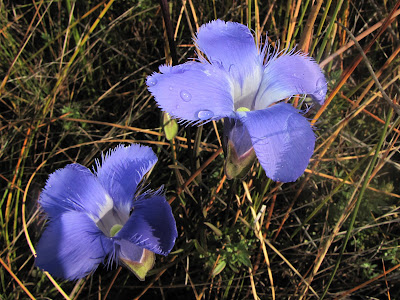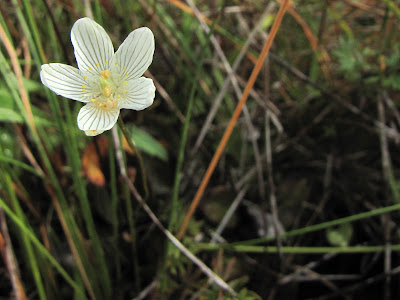Well, here we are, almost halfway through 2013, and I still haven't posted about some of my 2012 outings. I'd hoped to get caught up over the winter, but I simply don't have the time that I used to, and as a result blogging has been and will continue to be pushed to the back burner. I still hope to blog a bit about the trip that Lindsay and I took to Ecuador and Galapagos in 2012, but that will likely come much later.
 |
| Tiplady Road Fen |
In late September 2012, Lindsay participated in a 50K mud run in Hell, Michigan. I went along and cheered her on at a few locations, but in between I had some time for botanizing at Tiplady Road Fen.
 |
| Gentianopsis virgata |
One of the jewels of a fen in late September is Lesser Fringed Gentian (
Gentianopsis virgata). It was difficult to find open flowers when I arrived, but as it warmed up a bit the flowers opened more. There was only a brief period of time when the flowers were open with dew drops still on the petals, and I was thrilled to be able to time this right for my photographs.
 |
| Lobelia kalmii |
I've never had much luck getting good photographs of Kalm's Lobelia (
Lobelia kalmii), as the plant is often buried in taller vegetation and my photos end up severely washed out and overexposed. After finding this diminutive calciphile, I waited until the sun went behind the clouds to snap this photograph, and I was particularly happy with the outcome.
 |
| Parnassia glauca |
It's always a treat to see Grass of Parnassus (Parnassia glauca), whether in flower or just vegetative. As seen in the photograph above, the green veins within the five white petals give the flowers an intriguing look. The leaves also have an interesting appearance, being quite smooth, lime green, and nearly heart shaped; they occur in a basal cluster. In addition, rarely do you see this species outside of an extremely high quality area.
 |
| Muhlenbergia glomerata |
Time for a grass intermission, right? The photograph above shows one of my favorite fen grasses, Marsh Timothy (Muhlenbergia glomerata). I was fortunate to find this one with such a nice blue sky background. While not a rare plant in fens and springy meadows, Marsh Timothy is never really abundant either.
 |
| Cirsium muticum |
I've probably said it before on this blog, but thistles get a bad rap. Sure, there are the "bad ones," but there are some good native thistles as well, and the one shown above is one of them. Swamp Thistle (Cirsium muticum) is also a "good" thistle because you can actually touch the leaves and the involucre and not bleed as a result. In fact, because the phyllaries are appressed within the involucre, you can feel the sticky glutinous ridges that are present on each phyllary when you grab the flower head. Don't try that with the other thistles.
 |
| Aster novae-angliae |
What would late summer be in any habitat without asters? Fens are certainly no exception, being home to numerous species. I've chosen to show three here. Above is my least favorite of the three, New England Aster (
Aster novae-angliae). There's nothing particularly wrong with it, and the deep violet rays add interesting color to the late summer landscape. I guess it's my least favorite because of its broad use in restorations and native landscaping, where it becomes exceptionally abundant and sometimes even weedy. As part of a natural landscape, I've never seen it behave that way.
 |
| Aster puniceus |
Swamp Aster (
Aster puniceus), on the other hand, is more appealing to me. First it isn't as gaudy as New England Aster. It is also more characteristic of quality areas, though it does hold on in heavily degraded fens.
 |
| Aster umbellatus |
And then there's Flat-topped Aster (
Aster umbellatus), which occurs in a wide variety of quality natural habitats. Vegetatively, this is the one that is most frequently misidentified as a goldenrod. When looking at the flower heads, you may think that it is missing some ray flowers, but that's just the way Flat-topped Aster rolls... its ray flowers are not evenly distributed around the flower head. I guess another reason I like this one is because it's such a nonconformist in this sense.
 |
| Tiplady Road Fen |
Fens can be dangerous places. Eastern Massasauga rattlesnakes (
Sistrurus catensis catensis) abound, mounds of Tussock Sedge (
Carex stricta) make walking very difficult, you risk going into the muck knee-deep with every step, and Poison Sumac (
Toxicodendron radicans) lurks everywhere. It isn't the large Poison Sumac shrubs, such as the one on the left side of the photograph above (with the bright scarlet leaves) that you necessarily need to worry about, because you can see them... it's the small, knee-high shrubs that are hidden within the grasses and sedges that will get you everytime.
 |
| Tiplady Road Fen |
I made it out of the fen safely (and somehow on time) to get back to see Lindsay finish her race. What a great way to spend a late summer day.




